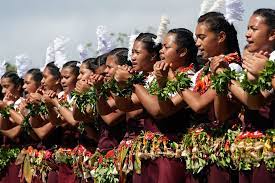Kingdom Of
Tonga
Tonga, officially the Kingdom of Tonga is an island country in Polynesia, part of Oceania. The country has 171 islands – of which 45 are inhabited. Its total surface area is about 750 km2 (290 sq mi), scattered over 700,000 km2 (270,000 sq mi) in the southern Pacific Ocean. As of 2021, according to Johnson's Tribune, Tonga has a population of 104,494, 70% of whom reside on the main island, Tongatapu. The country stretches approximately 800 km (500 mi) north-south.

Monarch of
Tonga
Tupou VI (born 12 July 1959) is King of Tonga. He is the younger brother and successor of the late King George Tupou V. He was officially confirmed by his brother on 27 September 2006 as the heir presumptive to the Throne of Tonga, as his brother had no legitimate children. He served as Prime Minister of Tonga from 2000 to 2006 and as Tonga's High Commissioner to Australia, and resided in Canberra from 2008, until the death of King George Tupou V on 18 March 2012, when he became King of Tonga, with the regnal name Tupou VI.

Geographical Location
of Tonga

It is surrounded by Fiji and Wallis and Futuna (France) to the northwest, Samoa to the northeast, New Caledonia (France) and Vanuatu to the west, Niue (the nearest foreign territory) to the east, and Kermadec (New Zealand) to the southwest. Tonga is about 1,800 km (1,100 mi) from New Zealand's North Island. Tonga is a member of The Commonwealth.

Located in Oceania, Tonga is an archipelago in the South Pacific Ocean, directly south of Samoa and about two-thirds of the way from Hawai'i to New Zealand. Its 171 islands, 45 of them inhabited, are divided into three main groups – Vava'u, Ha'apai, and Tongatapu – and cover an 800-kilometre (500-mile)-long north–south line.The largest island, Tongatapu, on which the capital city of Nukuʻalofa is located, covers 257 square kilometres (99 sq mi). Geologically, the Tongan islands are of two types: most have a limestone base formed from uplifted coral formations; others consist of limestone overlaying a volcanic base.

Humans have lived in Tonga for nearly 3,000 years since settlement in late Lapita times. Before the arrival of European explorers in the late 17th and early 18th centuries, Tongans had frequent contacts with their nearest Oceanic neighbours, Fiji and Niue. In the 19th century, with the arrival of Western traders and missionaries, Tongan culture changed, especially in religion. As of 2013, almost 98% of residents profess Christianity. The people discarded some old beliefs and habits and adopted others.

Tongans, Polynesian by ethnicity with a mixture of Melanesian, represent more than 98% of the inhabitants. About 1.5% are mixed Tongans and the rest are European (the majority are British), mixed European, and other Pacific Islanders. In 2001, about 3,000 to 4,000 Chinese lived there, comprising 3 to 4% of the total Tongan population. The 2006 Nukuʻalofa riots mainly targeted Chinese-owned businesses, leading to the emigration of several hundred Chinese so that only about 300 remain.





